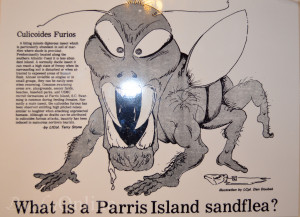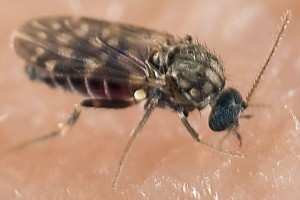What are No-see-ums?
You are enjoying a warm and sunny Saturday morning watching your child’s game on the bleachers when you are swarmed by tiny, hungry little gnats. The bites leave white swollen dots surrounded by irritated red skin. Sand gnats are blood-sucking insects that live in sandy and moist areas like we have here on the marshy coast. They come in all different shapes and sizes, but around here, they are so small and gray (almost translucent) that you can barely see them- hence the local name: “no-see-ums.” It is appropriate that they are sometimes called punkies as well. “Punk” is defined as a young ruffian or hoodlum.
They are so elusive that it is hard to give a physical description; they are very generic in appearance, but surely you would see large fangs if you could catch and mount one under a microscope. These insects have such a distracting and persistent presence that humor seems to be the only working defense if you are caught without AVON.

Though it is not documented, the second story porches on Beaufort’s historic houses make the perfect place to hide from no-see-ums because they cannot fly over sixteen feet. According to Beaufort historian Larry Rowland, the Spanish, who keep detailed written records of their explorations, took the time to lament these biting insects in the 1500’s. It is a wonder that natives were discovered here at all unless they had natural repellents for no-see-ums. In present day, Savannah’s baseball team is called the Sand Gants, which is intimidating for anyone who has been in a cloud of the real thing.
No-see-um bites tend to itch for five to ten minutes without treatment. Coat the bite with Neosporin (triple antibiotic ointment) and apply ice for relief. Many of the carriage horses in Waterfront Park are from the Amish country in Ohio, and no-see-ums will give the more sensitive among them a strong allergic reaction. The horses are treated with allergy shots and a garlic mixture of bug spray. “They annoy livestock and can even transmit nematode diseases to cattle,” writes Dennis Adams for the Beaufort County Library article “Sand Flies.”
 In most cases, the worst danger to humans is allergic reaction to the bites or infection from over-zealous scratching. Andrew Theen, who wrote an article called “Sand gnats have many nicknames but a singular goal: annoyance” for Medill News Service for Military Times confirms that sand gnats are gaining attention elsewhere. James Clark, environmental compliance department manager at MCRD Parris Island has been on site for nineteen years: “If you’re outside it’s miserable. They’ll just totally encrust your arm. They bite and they chew. It hurts a lot more than a mosquito bite.” Marines are trained on Parris Island not only because of exhaustive heat conditions and humidity, but also because surviving the no-see-um outbreaks is a test of any soldier’s endurance.
In most cases, the worst danger to humans is allergic reaction to the bites or infection from over-zealous scratching. Andrew Theen, who wrote an article called “Sand gnats have many nicknames but a singular goal: annoyance” for Medill News Service for Military Times confirms that sand gnats are gaining attention elsewhere. James Clark, environmental compliance department manager at MCRD Parris Island has been on site for nineteen years: “If you’re outside it’s miserable. They’ll just totally encrust your arm. They bite and they chew. It hurts a lot more than a mosquito bite.” Marines are trained on Parris Island not only because of exhaustive heat conditions and humidity, but also because surviving the no-see-um outbreaks is a test of any soldier’s endurance.
 No-see-ums enjoy lovely weather just as we do. Mornings and evenings in the spring and fall are times of the plague. They do tend to avoid blaring sunshine and heat in the middle of the day. When you see your shadow extending across the ground in late afternoon, you must start walking…or running. These insects have difficulty with a moving target, and they cannot make contact on a very windy day. Avoid kicking up wet leaves and dirt, as this is where the gnats take refuge and raise their spawn. According to Rick Steinau (asktheexterminator.com), blood is necessary for these little vampires because the females “need high levels of protein in their blood to make their eggs mature. It’s nothing personal.”
No-see-ums enjoy lovely weather just as we do. Mornings and evenings in the spring and fall are times of the plague. They do tend to avoid blaring sunshine and heat in the middle of the day. When you see your shadow extending across the ground in late afternoon, you must start walking…or running. These insects have difficulty with a moving target, and they cannot make contact on a very windy day. Avoid kicking up wet leaves and dirt, as this is where the gnats take refuge and raise their spawn. According to Rick Steinau (asktheexterminator.com), blood is necessary for these little vampires because the females “need high levels of protein in their blood to make their eggs mature. It’s nothing personal.”
Wear clothing that covers as much skin as you can tolerate on a hot day. A nudist colony on Cat Island was driven away in the early 1930’s, compromised by their natural lifestyle. Every inch of clothing is precious; unlike the Lowcountry mosquitoes, no-see-ums cannot punch through denim. They can, however push their tiny bodies through 16-mesh insect screen. A mosquito net will not protect your face. Wear a baseball hat to protect your hairline and spray generously with DEET. Many people in this area swear by AVON Skin so Soft. Coat exposed skin generously with this oil as it seems to suffocate the insects before they can bite. Local grocery stores sell an all-organic product called “No Natz: the BEST bug spray available to repel Gnats and Marsh Flies.” No Natz was created in Georgia and first used while boating on the Wilmington River.
